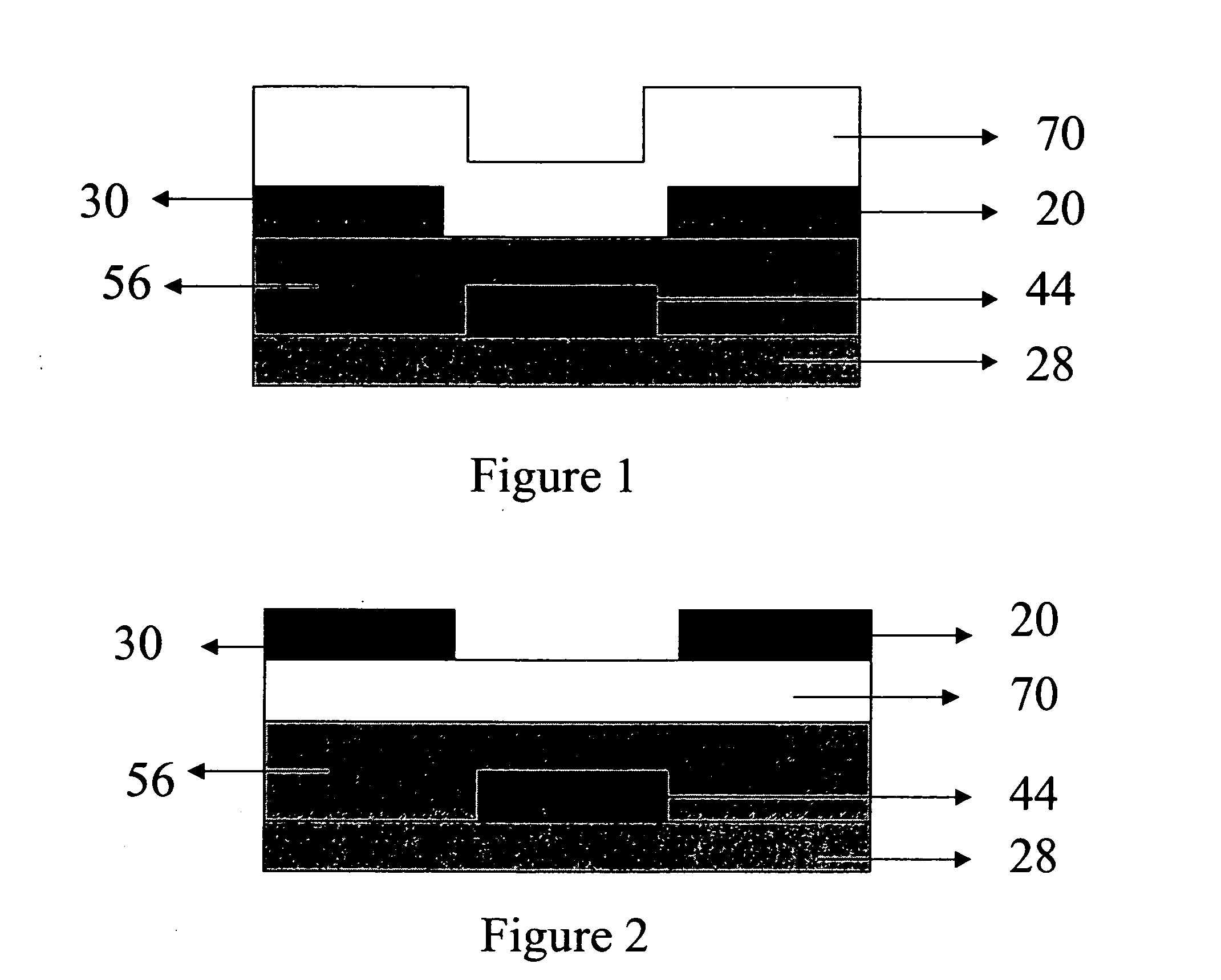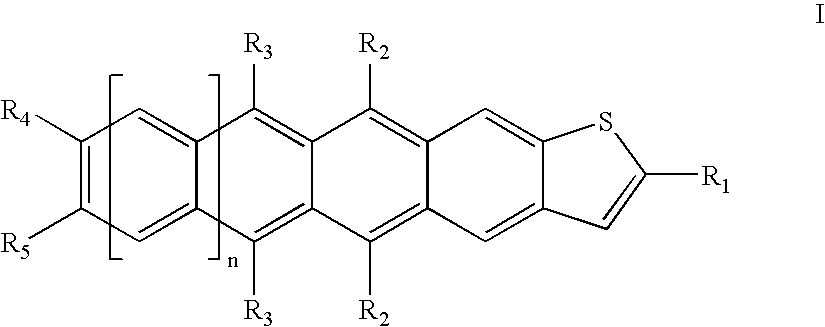Acene compounds having a single terminal fused thiophene as semiconductor materials for thin film transistors and methods of making the same
a technology of fused thiophene and acene compounds, which is applied in the field of acene compounds, can solve the problems of amorphous silicon still having its drawbacks, amorphous silicon still has its drawbacks, and limited application of amorphous silicon to low speed devices
- Summary
- Abstract
- Description
- Claims
- Application Information
AI Technical Summary
Benefits of technology
Problems solved by technology
Method used
Image
Examples
example i
[0072] The active layer of Structure I was deposited via vacuum deposition in a thermal evaporator. A heavily doped silicon wafer with a thermally grown SiO2 layer with a thickness of 165 nm was used as the substrate. The wafer was cleaned for 10 minutes in a piranha solution, followed by a 6-minute exposure in an UV / ozone chamber. The cleaned surface was then treated with a thin layer of polystyrene by spin coating.
[0073] The purified semiconducting material was deposited by vacuum sublimation at a pressure of 5×10−7 Torr and a rate of 0.5 Angstroms per second to a thickness of 40 nm as measured by a quartz crystal. During deposition the substrate was held at a constant temperature of 60° C. The sample was exposed to air for a short time prior to subsequent deposition of Ag source and drain electrodes through a shadow mask to a thickness of 50 nm. The devices made had a 500 micron channel width, with channel lengths varying from 20-80 microns. The mobility was 5.38×10−3 cm2 / V-s, a...
example ii a and ii b
[0074] The active layer of Structure II was deposited via spin coating at 1200 rpm from a 0.2 wt % solution in chlorobenzene (A) or fluorobenzene (B). A heavily doped silicon wafer with a thermally grown SiO2 layer with a thickness of 215 nm was used as the substrate. The wafer was cleaned for 10 minutes in a piranha solution, followed by a 6-minute exposure in an UV / ozone chamber. The surface had no further treatments. Immediately following semiconductor deposition, Au source and drain electrodes were evaporated through a shadow mask to a thickness of 50 nm. The devices made had a 500 micron channel width, with channel lengths varying from 20-100 microns. Devices spun from chlorobenzene resulted in mobilities of 5.0×10−1 cm2 / N-s, and the on / off ratio was 2.9×105. Devices spun from fluorobenzene resulted in mobilities of 8.0×10−2 cm2 V-s, and the on / off ratio was 2.10×105.
example iii a and iii b
[0075] The active layer of Structure III was deposited via spin coating at 1200 rpm from a 0.2 wt % solution in isopropyl alcohol (A) or chlorobenzene (B). A heavily doped silicon wafer with a thermally grown SiO2 layer with a thickness of 215 nm was used as the substrate. The wafer was cleaned for 10 minutes in a piranha solution, followed by a 6-minute exposure in an UV / ozone chamber. The surface had no further treatments. Immediately following semiconductor deposition, Au source and drain electrodes were evaporated through a shadow mask to a thickness of 50 nm. The devices made had a 500 micron channel width, with channel lengths varying from 20-100 microns. Devices spun from isopropyl alcohol resulted in a maximum mobility of 1.08×10−4 cm2 / V-s, with an on / off ratio of 9.40×102. Devices spun from chlorobenzene resulted in a mobility of 6.0×10−6 cm2 / V-s, with an on / off ratio of 5.5×102.
C. Device Measurement and Analysis
[0076] Electrical characterization of the fabricated device...
PUM
| Property | Measurement | Unit |
|---|---|---|
| temperature | aaaaa | aaaaa |
| gate voltage | aaaaa | aaaaa |
| diameter | aaaaa | aaaaa |
Abstract
Description
Claims
Application Information
 Login to View More
Login to View More - R&D
- Intellectual Property
- Life Sciences
- Materials
- Tech Scout
- Unparalleled Data Quality
- Higher Quality Content
- 60% Fewer Hallucinations
Browse by: Latest US Patents, China's latest patents, Technical Efficacy Thesaurus, Application Domain, Technology Topic, Popular Technical Reports.
© 2025 PatSnap. All rights reserved.Legal|Privacy policy|Modern Slavery Act Transparency Statement|Sitemap|About US| Contact US: help@patsnap.com



